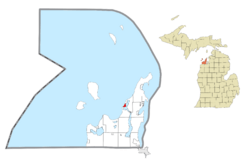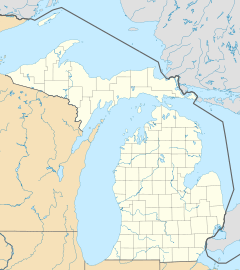Leland, Michigan facts for kids
Quick facts for kids
Leland, Michigan
|
|
|---|---|

Historic Fishtown along the Leland River
|
|
| Nickname(s):
Fishtown
|
|

Location within Leelanau County
|
|
| Country | |
| State | |
| County | |
| Township | Leland |
| Settled | 1853 |
| Area | |
| • Total | 1.00 sq mi (2.58 km2) |
| • Land | 0.98 sq mi (2.53 km2) |
| • Water | 0.02 sq mi (0.06 km2) |
| Elevation | 581 ft (177 m) |
| Population
(2020)
|
|
| • Total | 410 |
| • Density | 420.08/sq mi (162.26/km2) |
| ZIP code(s) |
49654
|
| Area code(s) | 231 |
| FIPS code | 26-46800 |
Leland (/ˈliːlənd/ LEE-lənd) is a small community in the state of Michigan, USA. It's known as an unincorporated community and a census-designated place (CDP). This means it's a recognized place but doesn't have its own city government.
Leland is located in Leelanau County, in the northwest part of Michigan's Lower Peninsula. In 2020, about 410 people lived there. For many years, from 1883 to 2004, Leland was the main government center, or county seat, for Leelanau County. Now, the county seat is in Suttons Bay Township.
Leland is special because it sits on a narrow strip of land between two large lakes: Lake Leelanau and Lake Michigan. The Leland River flows right through the middle of town, connecting these two lakes. Leland is a very popular spot for tourists and a favorite place for people to spend their summers. It's also close to the beautiful Sleeping Bear Dunes National Lakeshore. From Leland, you can catch a ferry to visit North and South Manitou Islands, which are part of the National Lakeshore.
Contents
History of Leland
Leland was built on the site of a very old and large village of the Odawa people, a Native American tribe. This village was on the Leelanau Peninsula. Where the Leland River meets Lake Michigan, there was a natural "fish ladder." This was a perfect spot for Native Americans to fish. The village was called Mishi-me-go-bing, which means "the place where canoes run up into the river to land, because they have no harbor."
White settlers started arriving in the 1830s. They also found the area great for fishing. More settlers came after Antoine Manseau, his son Antoine Jr., and John Miller built a dam and a sawmill on the river in 1854. The dam made the water level rise about 12 feet. What used to be three separate lakes in the river became one large lake, now called Lake Leelanau. This lake is so big that you can travel by boat all the way to the community of Cedar, about 13 miles inland! The settlers also built wooden docks. These docks allowed large boats called steamers and schooners to bring new settlers and supplies.
From 1870 to 1884, a company called Leland Lake Superior Iron Co. had an iron smelter north of the river mouth. A smelter is a place where metal is taken out of rock using heat. They got iron ore from Michigan's Upper Peninsula. They made charcoal from local maple and beech trees to fuel the smelter. The charcoal was made in 14 special ovens called beehive kilns. This smelter could make up to 40 tons of iron every day! In 1884, the plant was sold to the Leland Lumber Co., which used the site for a sawmill. Other sawmills also operated in Leland between 1885 and 1900.
By 1880, people were fishing for a living from the harbor. They caught trout and whitefish. They built small wooden buildings, known as "shacks," where they prepared their fish and fixed their fishing boats. Up to eight powerful fishing boats, called tugs, used to sail out of this area, which became known as "Fishtown." Today, a non-profit group called the Fishtown Preservation Society owns this historic fishing village. They also own two old fishing tugs, the Joy and the Janice Sue. Fishtown is still a working fishing area, and you can also find businesses that offer fishing trips. A boardwalk lines the river, and the old shacks have been turned into cute tourist shops.
Around 1900, rich people from big cities like Chicago and Detroit started visiting Leland. They built summer houses here. They would arrive by passenger boats on Lake Michigan or by boats on Lake Leelanau. This led to hotels being built, and Leland grew into a popular summer resort town.
Geography
Leland is located in the northern part of Leelanau County, on the western side of the Leelanau Peninsula. To its west is Lake Michigan, and to its east is the northern part of Lake Leelanau. The Leland River flows through the middle of the community, connecting these two lakes.
According to the U.S. Census Bureau, the Leland area covers about 1 square mile (2.58 square kilometers). Most of this area is land (0.98 square miles or 2.53 square kilometers), and a small part is water (0.02 square miles or 0.06 square kilometers).
Leland is just north of the 45th parallel. This is an imaginary line around the Earth. A sign on M-22 south of Leland tells you that this spot is "Halfway Between Equator & North Pole".
Population Information
| Historical population | |||
|---|---|---|---|
| Census | Pop. | %± | |
| 2010 | 377 | — | |
| 2020 | 410 | 8.8% | |
| U.S. Decennial Census | |||
Getting Around
 M-22: This is the main road that connects Leland to other parts of the county. It goes northeast about 11 miles to Northport and southwest about 18 miles to Glen Arbor.
M-22: This is the main road that connects Leland to other parts of the county. It goes northeast about 11 miles to Northport and southwest about 18 miles to Glen Arbor.- Manitou Island Transit: This is a ferry service that takes people to North and South Manitou Islands.
Places to Visit
- Leelanau Historical Society and Museum: You can learn about the history of the area here. It's at 203 East Cedar Street.
- Leland Township Library: A great place to find books and information, also at 203 East Cedar Street.
Historic Sites in Michigan
Leland has several buildings and areas that are recognized as important historical sites in Michigan:
- Walter Best Women's Club (Old Art Building), 1125 Main Street
- Riverside Inn, 302 East River Street
- Leelanau County Jail, 106 Chandler Street
- Leland Historic District (Fishtown)
- Greycote Cottage, 110 Pearl Street
- W. K. Hatt Cottage, 410 North Main Street
Images for kids
-
Aerial view of Leland Harbor and Lake Michigan
-
Buildings along the Leland River
Famous People From or Connected to Leland
- Tim Allen (born 1953), a famous comedian and actor.
- Thomas W. L. Ashley (1923-2010), a U.S. representative from Ohio.
- The Ball Brothers, who were important business people and gave a lot to charity.
- Charles E. Bennison (born 1943), an Episcopal bishop.
- Barbara Ninde Byfield (1930-1988), an author and illustrator.
- Mark Clark (1896-1984), a general in World War II.
- John J. Gilligan (1921-2013), a U.S. representative and governor of Ohio.
- Alisha Glass (born 1988), an Olympic volleyball player.
- Jim Harrison (1937-2016), an author who lived in the township for many years.
- Harlan Hatcher (1898-1998), a former president of the University of Michigan.
- Arthur F. Lederle (1887–1972), a U.S. federal judge.
- Alvin Mansfield Owsley (1888-1967), a lawyer and diplomat.
- Keewaydinoquay Peschel (ca. 1919-1999), an expert on plants and their uses, a herbalist, and an educator.
- Emelia Schaub (1891-1995), a county prosecutor and the first female attorney in Michigan.
- Kathleen Sebelius (born 1948), a former U.S. Secretary of Health and Human Services and governor of Kansas. She is the daughter of John J. Gilligan.
- Tobin Sprout (born 1955), a songwriter and guitarist for the band Guided by Voices.
See also
 In Spanish: Leland (Míchigan) para niños
In Spanish: Leland (Míchigan) para niños












